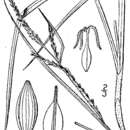Comments
provided by eFloras
Variants of Carex aestivalis with larger perigynia have been collected from Virginia and North Carolina. Carex aestivalis apparently hybridizes with C. gracillima and C. virescens.
- license
- cc-by-nc-sa-3.0
- copyright
- Missouri Botanical Garden, 4344 Shaw Boulevard, St. Louis, MO, 63110 USA
Description
provided by eFloras
Plants densely cespitose. Culms dark maroon at base; flowering stems 25–60 cm, usually longer than leaves at maturity, 0.5–0.7 mm thick, glabrous or sparsely pubescent, finely scabrous within inflorescence. Leaves: basal sheaths maroon, bladeless, pubescent; others grading from maroon to green on back, pale brown-hyaline, red dotted and usually pubescent on front; blades flat, 1.5–3 mm wide, glabrous or sparsely pubescent on both surfaces, especially near sheath, finely scabrous on margins. Inflorescences: peduncles of lateraal spikes 5–25 mm, shorter than spikes, glabrous; peduncle of terminal spike 5–25 mm, glabrous; proximal bracts often equaling or exceeding inflorescences; sheaths to 9 mm; blades 1–2 mm wide. Lateral spikes 2–4, 1 per node, well separated, erect or arching, pistillate with 15–30 perigynia attached 1 mm apart distally and 3 mm apart proximally, linear, 15–50 × 3–3.5 mm. Terminal spike gynecandrous, 20–35 × 1.5–3.5 mm. Pistillate scales pale hyaline, tinged with golden or reddish brown, with broad green midrib, red dotted, oblong-elliptic, shorter than mature perigynia, apex obtuse to cuspidate, glabrous. Perigynia green, copiously red dotted, 2-ribbed and finely 12–15-veined, loosely enveloping achene, ovoid-ellipsoid, 2–3.2 × 0.8–1 mm, membranous, base with short stipe, gradually tapering to acute beakless apex, glabrous. Achenes distinctly stipitate, 1.8–2.1 × 0.8–1 mm, stipe 0.5 mm. 2n = 56.
- license
- cc-by-nc-sa-3.0
- copyright
- Missouri Botanical Garden, 4344 Shaw Boulevard, St. Louis, MO, 63110 USA
Distribution
provided by eFloras
Ala., Ga., Ky., Md., N.Y., N.C., Pa., S.C., Tenn., Vt., Va., W.Va.
- license
- cc-by-nc-sa-3.0
- copyright
- Missouri Botanical Garden, 4344 Shaw Boulevard, St. Louis, MO, 63110 USA
Habitat
provided by eFloras
Dry to mesic forests, seepage slopes, and meadows in the mountains; to 1600m.
- license
- cc-by-nc-sa-3.0
- copyright
- Missouri Botanical Garden, 4344 Shaw Boulevard, St. Louis, MO, 63110 USA
Comprehensive Description
provided by North American Flora
Carex aestivalis M. A. Curt.; A. Gray, Am. Jour. Sci 42:28. 1842.
Carex Darlingtonii Schw.; M. A. Curt. Am. Jour. Sci. II. 7: 410, as synonym. 1849.
Carex Rugeliana Kunze, Suppl. Riedgr. 189, in part. pi. 48. 1851. (Type from North Carolina.)
Carex tabularia M. A. Curt.; Boott, 111. Carex 54, as synonym. 1858.
Carex virescens var. aestivalis Olney, Caric. Bor.-Am. 5. 1871. (Based on C. aestivalis M. A. Curt.)
Cespitose and not stoloniferous, the culms 3-6 dm. high, erect, slender, mostly exceeding the upper leaves, aphyllopodic, triangular, sparingly pubescent and roughened on the angles, reddish-purple at base ; leaves with well-developed blades about 3 to a culm, on lower half, not at all bunched, the blades essentially glabrate, but with traces of pubescence, especially below and towards the base, flat, flaccid, deep-green, 7-20 cm. long, 1.5-2.5 mm. wide, erect-ascending, the upper culm-leaf inserted about halfway up the culm, the sheaths tight, long pubescent especially ventrally, yellowish-brown-tinged and red-dotted ventrally, deeply concave at mouth, the ligule longer than wide; spikes about 4, linear-cylindric, 2-4 cm. long, 2-3 mm. thick, the lower half of the uppermost staminate, the remainder pistillate, all erect and from nearly sessile to strongly (1.5 cm. long) peduncled (the peduncles smooth or nearly so), approximate, or the lower more or less separate, the pistillate portion of the uppermost spike rather closely flowered, the remaining spikes with 15-30 perigynia in few rows, loosely flowered, especially below; lower bract 1—1.5 mm. wide, exceeding the inflorescence, strongly sheathing, the others much smaller, sheathless or nearly so; scales of pistillate flowers ovate or obovate, small, about one half the length of the perigynia, from slightly cuspidate to obtusish, greenishwhite and slightly reddish-tinged, with sharply defined green midrib and hyaline margins; scales of staminate flowers larger, closely appressed, ovate-oblong, acute or cuspidate, greenishwhite with hyaline straw-colored margins; perigynia oblong-lanceolate, 2.5-3 mm. long, about 1 mm. wide, rather sharply triangular, not at all inflated, smooth, membranaceous, deepgreen, puncticulate, 2-ribbed and obscurely several-nerved, tapering and broadly stipitate and somewhat spongy at base, tapering at apex, the orifice entire; acholics oblong-obovoid, 1.75-2 mm. long, 1.25 mm. wide, strongly triangular with concave sides and rather prominent angles, completely filling the lower part of the perigynium, brownish, tapering at base, subapiculate, jointed with the straight slender style 0.75 mm. long; stigmas 3, short, slender, reddish-brown.
Type locality: "Hab. in montibus altioribus Carolinae septentrionalis ubique." Distribution: Dry mountain woods, New Hampshire, Massachusetts, and northern New York to Georgia. (Specimens examined from Vermont, Massachusetts, New York, Pennsylvania, Virginia, North Carolina.)
- bibliographic citation
- Kenneth Kent Mackenzie. 1935. (POALES); CYPERACEAE; CARICEAE. North American flora. vol 18(5). New York Botanical Garden, New York, NY
Carex aestivalis: Brief Summary
provided by wikipedia EN
Carex aestivalis, the summer sedge, is a species of Carex native to North America. The specific epithet, aestivalis, is derived from Latin and means "pertaining to the summer".
- license
- cc-by-sa-3.0
- copyright
- Wikipedia authors and editors

